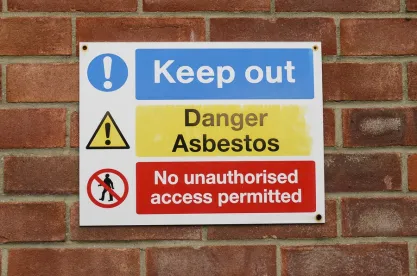Most lawyers begin learning about torts by reading the Palsgraf case. Palsgraf established the principle of foreseeability as the basis for imposing a duty. But are the principles from Palsgraf still relevant today?
In Palsgraf, Judge Cardozo famously held that a railroad did not owe a duty to a bystander who was injured after a passenger dropped a package of explosives, causing a set of scales to fall and injure the bystander—the injury was too indirect to be foreseeable to the railroad company. While the foreseeability framework may work to limit the scope of a duty when a series of bizarre events results in an injury, the framework becomes less predictable when applied in other contexts. Take, for example, “take-home” asbestos litigation. These cases involve suits against employers by people – not employees – who come into regular contact with asbestos on an employee’s clothing outside of the workplace.
Employer liability for take-home asbestos exposure depends largely on the state in which the employer sits. States are currently split on whether employers owe a duty of care to people injured after being exposed to asbestos that an employee brought home. And both sides of the debate are adding additional states to their camp.
State courts in Delaware, California, New Jersey, Tennessee, Washington, and Louisiana have held that employers have a duty to cohabitants of employees who allege that they regularly inhaled dust from the employees’ work clothing based on the foreseeable risk of exposure from asbestos brought home on that clothing. New York, Georgia, Kentucky, Oklahoma, Ohio, Maryland, and Michigan state courts have held that employers do not owe a duty to employees’ spouses or other household members, recognizing that employers may be subject to limitless liability if they had a duty to anyone who may regularly come into contact with their employees’ clothing.
Courts have split on this issue based on what test they apply. Some focus on whether the plaintiff must have a special relationship to the employer for a duty to exist, and others focus on whether the foreseeability of the harm creates a duty.
In 2018, Virginia and Arizona came down on opposite sides of the issue. In Quiroz v. Alcoa Inc., the Supreme Court of Arizona held that an employer did not have a duty to protect an employee’s son from secondary exposure to asbestos fibers because the employer did not have a special relationship with the son.[1] The court defined a special relationship as a relationship created by state common law, contracts, or conduct undertaken by the defendant such as a landowner’s decision to invite a person to enter the premises to conduct business, implying the premises is safe for the invitee.
By contrast, in Quisenberry v. Huntington Ingalls Inc., the Supreme Court of Virginia held that an employer was liable to an employee’s daughter for the injury caused by the employee’s take-home asbestos exposure because she was within the zone of danger created by the employer’s conduct and there was a “recognizable risk of harm” of take-home exposure. The court concluded that it was foreseeable that cohabitants of the employee could be injured by inhaling the dust on the employee’s work clothes.[2]
So which test makes more sense in take-home asbestos litigation? The main issue with imposing liability on employers for harm caused to a cohabitant who comes into contact with the asbestos dust on an employee’s clothes is the lack of a limiting principle. The Virginia court stated that “innocent cohabitators” were within the foreseeable area of risk, and the employer had a duty to the cohabitator because that person was “within reach” of the hazard created by the employer’s conduct.[3] The court, however, did not explain who might be in this class of protected plaintiffs: could a babysitter, a housekeeper, a daytime nanny count as an “innocent cohabitator” even though they don’t live with the employee? The circularity of the foreseeability framework is that it assumes that if an individual interacted with the employee frequently enough to contract an illness from the exposure, then the injury itself is evidence that the harm caused by asbestos dust on clothing that leaves the workplace was foreseeable. But almost any plaintiff could fall into this ever-expanding zone of danger.
The premises liability concept of “mobile hazards” that are created on the property but cause harm when they leave the property and enter the surrounding neighborhood similarly does not work here. The Virginia Supreme Court in Quisenberry used this analogy when it compared the employer to a premises owner who is responsible for the negligent discharge of toxic chemicals because it was an “artificial hazard of defendant’s making.”[4]But unlike the premises owner who can control the machine or method by which the injury-producing agents— the toxic chemicals— are transported from the property, an employer must grapple with human agency when attempting to contain the spread of asbestos dust from a workplace. The employer ultimately cannot control where the asbestos dust on an employee’s work clothes travels once the employee leaves a work site, despite any warnings or laundry facilities provided on site to reduce any take-home exposure.[5]
One way to clarify the duty framework is to limit liability to plaintiffs who have special relationships with the employer. Courts imposing a duty based on a special relationship, such as a landlord-tenant or landowner-invitee relationship, can more clearly draw the line as to liability for mobile hazards. This approach would sharply narrow the class of plaintiffs who could obtain relief from the employer. Another approach would be to limit liability to those plaintiffs who reside in the same household as the employee. Although an employer may not be able to control the range of this exposure, injuries to cohabitants are at least more predictable than injuries to a diverse class of individuals who come into routine contact with the employee.
Courts adjudicating take-home liability cases are faced with the difficult task of striking a balance between setting clear precedents and providing remedies to plaintiffs facing terminal illnesses. To that end, the optimal balance would create space for public policy concerns within a framework that provides clear lines of liability for prospective defendants.
[1] 416 P.3d 824, 832 (Ariz. 2018).
[2] 818 S.E.2d 805 (Va. 2018).
[3] Id. at 811.
[4] Id.
[5] See In re New York City Asbestos Litig., 5 N.Y.3d 486, 495 (2005).



 />i
/>i

